| Listing 1 - 10 of 15 | << page >> |
Sort by
|
Book
ISBN: 0951881124 9780951881125 Year: 1995 Volume: 3 Publisher: Binghamton, N.Y. Medieval & Renaissance Texts & Studies
Abstract | Keywords | Export | Availability | Bookmark
 Loading...
Loading...Choose an application
- Reference Manager
- EndNote
- RefWorks (Direct export to RefWorks)
Book history
---
Wittenberg
---
Library catalogs
---
017.1 <43 WITTENBERG>
---
094.2 <43 JENA>
---
284.1 <43> "15"
---
378.4 <43 WITTENBERG>
---
284.1 <43> "15" Lutheraanse hervorming. Reformatie van Luther--Duitsland voor 1945 en na 1989--?"15"
---
Lutheraanse hervorming. Reformatie van Luther--Duitsland voor 1945 en na 1989--?"15"
---
017.1 <43 WITTENBERG> Catalogi van institutionele bibliotheken--Duitsland voor 1945 en na 1989--WITTENBERG
---
Catalogi van institutionele bibliotheken--Duitsland voor 1945 en na 1989--WITTENBERG
---
378.4 <43 WITTENBERG> Universiteiten--Duitsland voor 1945 en na 1989--WITTENBERG
---
Universiteiten--Duitsland voor 1945 en na 1989--WITTENBERG
---
094.2 <43 JENA> Oude drukken: bibliotheekcatalogi--
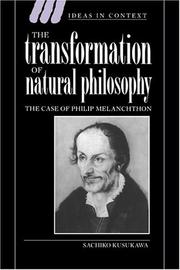
ISBN: 0521473470 0521030463 0511598521 Year: 1995 Volume: 34 Publisher: Cambridge : Cambridge University Press,
Abstract | Keywords | Export | Availability | Bookmark
 Loading...
Loading...Choose an application
- Reference Manager
- EndNote
- RefWorks (Direct export to RefWorks)
This book proposes that Philip Melanchthon was responsible for transforming traditional university natural philosophy into a specifically Lutheran one. Motivated by desire to check civil disobedience and promote a Lutheran orthodoxy, he created a natural philosophy based on Aristotle, Galen and Plato, incorporating contemporary findings of Copernicus and Vesalius. The fields of astrology, anatomy, botany and mathematics all constituted a natural philosophy in which Melanchthon wished to demonstrate God's Providential design in the physical world. Rather than dichotomizing or synthesizing the two distinct areas of 'science' and 'religion', Kusukawa advocates the need to look at 'Natural philosophy' as a discipline quite different from either 'modern science' or 'religion': a contextual assessment of the implication of the Lutheran Reformation on university education, particularly on natural philosophy.
Hervorming (Luther, e.a.) --- Reformatie --- Reformation --- Réforme (Luther e.a.) --- Reformation. --- Religion and science --- Science --- Philosophy, Renaissance --- Education, Higher --- Réforme (Christianisme) --- Religion et sciences --- Sciences --- Philosophie de la Renaissance --- Enseignement supérieur --- History --- Philosophy --- Histoire --- Philosophie --- Melanchthon, Philipp, --- -Reformation --- -Christianity and science --- Geology --- Geology and religion --- Science and religion --- Protestant Reformation --- Church history --- Counter-Reformation --- Protestantism --- College students --- Higher education --- Postsecondary education --- Universities and colleges --- -History --- -Religious aspects --- Religious aspects --- Education --- Melanchthon, Philipp --- -Melanchthon, Philipp --- Réforme (Christianisme) --- Enseignement supérieur --- Christianity and science --- Melanchton, Philipp --- Melantton, Philippus --- Melanchthon, Philippus --- 16th century --- Education [Higher ] --- Europe --- Melanchthon, Philipp, - 1497-1560. --- Religion and science - History - 16th century. --- Education, Higher - Europe - History - 16th century. --- Melanchthon, Philip, --- Melancthon, --- Schwartzerd, Philipp, --- Schwartzerdt, Philipp, --- Didymus Faventinus, --- Faventinus, Didymus, --- Melantone, Filippo, --- Melanthon, Philippus, --- Melancton, Philip, --- Melancthon, Philip, --- Melanchton, Philippus, --- Melancthon, Philippe, --- Melankhton, Filipp, --- Arts and Humanities
Book
ISBN: 1283550296 9786613862747 0226465284 9780226465289 9780226465296 0226465292 Year: 2012 Publisher: Chicago London
Abstract | Keywords | Export | Availability | Bookmark
 Loading...
Loading...Choose an application
- Reference Manager
- EndNote
- RefWorks (Direct export to RefWorks)
Because of their spectacular, naturalistic pictures of plants and the human body, Leonhart Fuchs's De historia stirpium and Andreas Vesalius's De humani corporis fabrica are landmark publications in the history of the printed book. But as Picturing the Book of Nature makes clear, they do more than bear witness to the development of book publishing during the Renaissance and to the prominence attained by the fields of medical botany and anatomy in European medicine. Sachiko Kusukawa examines these texts, as well as Conrad Gessner's unpublished Historia plantarum, and demonstrates how their illustrations were integral to the emergence of a new type of argument during this period-a visual argument for the scientific study of nature. To set the stage, Kusukawa begins with a survey of the technical, financial, artistic, and political conditions that governed the production of printed books during the Renaissance. It was during the first half of the sixteenth century that learned authors began using images in their research and writing, but because the technology was so new, there was a great deal of variety of thought-and often disagreement-about exactly what images could do: how they should be used, what degree of authority should be attributed to them, which graphic elements were bearers of that authority, and what sorts of truths images could and did encode. Kusukawa investigates the works of Fuchs, Gessner, and Vesalius in light of these debates, scrutinizing the scientists' treatment of illustrations and tracing their motivation for including them in their works. What results is a fascinating and original study of the visual dimension of scientific knowledge in the sixteenth century.
Natural history illustration --- Botanical illustration --- Medical illustration --- Illustrated books --- Art and science --- Science and art --- Illustration, Medical --- Botanical drawing --- Flower painting and illustration --- Fruit painting and illustration --- Illustration, Botanical --- Nature illustration --- History --- Science --- Books --- Medicine and art --- Scientific illustration --- Biological illustration --- 094:58 --- 094:61 --- 76.043 --- 769.04:61 --- 76.043 Iconografie: flora in de prentkunst --- Iconografie: flora in de prentkunst --- 769.04:61 Prentenverzamelingen in de grafische kunsten. Iconografie. Iconologie-:-Geneeskunde. Hygiëne. Farmacie --- Prentenverzamelingen in de grafische kunsten. Iconografie. Iconologie-:-Geneeskunde. Hygiëne. Farmacie --- 094:61 Oude en merkwaardige drukken. Kostbare en zeldzame boeken. Preciosa en rariora-:-Geneeskunde. Hygiëne. Farmacie --- Oude en merkwaardige drukken. Kostbare en zeldzame boeken. Preciosa en rariora-:-Geneeskunde. Hygiëne. Farmacie --- 094:58 Oude en merkwaardige drukken. Kostbare en zeldzame boeken. Preciosa en rariora-:-Botany --- Oude en merkwaardige drukken. Kostbare en zeldzame boeken. Preciosa en rariora-:-Botany --- Fuchs, Leonhart. --- Gessner, Conrad --- Vesalius, Andreas --- Vesal, Andreas --- Vesale, André --- Vezalij, Andrej --- Gesner, Conrad --- Gesner, Konrad --- Gesnerus, Conradus --- Gessner, Konrad --- Fuchs, Leonhart --- Fuchsius, Leonhartus --- Natural history illustration - Europe - History - 16th century --- Botanical illustration - Europe - History - 16th century --- Medical illustration - History - 16th century --- Illustrated books - Europe - History - 16th century --- Art and science - History - 16th century --- humani corporis fabrica, andreas vesalius, de historia stirpium, leonhart fuchs, plantarum, conrad gessner, medicine, anatomy, botany, nature, visual culture, science, book printing, publishing, renaissance, research, writing, images, authority, representation, reference, nonfiction, scientific knowledge, illustrations, natural history, europe, copying, coloring, medicinal plants, human body, bloodletting, jamnitzer, mattioli.
Book
Year: 2012 Publisher: Chicago, Ill. University of Chicago Press
Abstract | Keywords | Export | Availability | Bookmark
 Loading...
Loading...Choose an application
- Reference Manager
- EndNote
- RefWorks (Direct export to RefWorks)
Book history --- Economic and applied botany --- Human anatomy --- illustration [process] --- anatomy --- history of medicine --- botanical illustrations --- book history --- anno 1500-1599
Book
Year: 2017
Abstract | Keywords | Export | Availability | Bookmark
 Loading...
Loading...Choose an application
- Reference Manager
- EndNote
- RefWorks (Direct export to RefWorks)
collecting, United Kingdom --- collecting curiosities --- Courten, William --- anno 1600-1699
Book
ISBN: 9781789148527 9781789148770 1789148774 Year: 2024 Publisher: London Reaktion Books
Abstract | Keywords | Export | Availability | Bookmark
 Loading...
Loading...Choose an application
- Reference Manager
- EndNote
- RefWorks (Direct export to RefWorks)
A revisionist biography of Andreas Vesalius--the father of modern anatomy--as deeply shaped by Renaissance culture. In 1543 the young and ambitious physician Andreas Vesalius published one of the most famous books in the history of medicine, On the Fabric of the Human Body. While we often think of dissection as destroying the body, Vesalius believed that it helped him understand how to construct the human body. In this book, Sachiko Kusukawa shows how Vesalius's publication emerged from the interplay of Renaissance art, printing technology, and classical tradition. She challenges the conventional view of Vesalius as a proto-modern, anti-authoritarian father of anatomy through a more nuanced account of how Vesalius exploited cultural and technological developments to create a big and beautiful book that propelled him into imperial circles and secured his enduring fame.
Book history --- History of human medicine --- Human anatomy --- anatomy --- boekdrukkunst --- Vesalius, Andreas --- Anatomie humaine --- Dessin d'anatomie. --- Médecine et art. --- Anatomy, Artistic --- Medicine and art. --- Anatomy, Artistic. --- Dans l'art. --- In art. --- Vésale, André, --- Vesalius, Andreas,
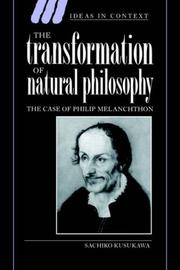
ISBN: 9780511598524 9780521473477 9780521030465 Year: 1995 Publisher: Cambridge Cambridge University Press
Abstract | Keywords | Export | Availability | Bookmark
 Loading...
Loading...Choose an application
- Reference Manager
- EndNote
- RefWorks (Direct export to RefWorks)
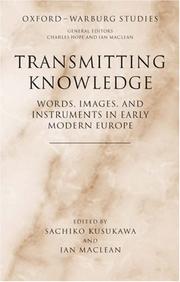
ISBN: 019928878X 9780199288786 Year: 2006 Volume: *12 Publisher: New York, N.Y. Oxford University Press
Abstract | Keywords | Export | Availability | Bookmark
 Loading...
Loading...Choose an application
- Reference Manager
- EndNote
- RefWorks (Direct export to RefWorks)
Based on new research, a distinguished international team studies the forms in which scientific knowledge was transmitted in the late medieval and early modern period, the ways they interacted, and the people to whom the knowledge was directed. Among the famous authors whose work is examined here are Fuchs, Vesalius, Tycho Brahe, and Descartes.
Philosophy of science --- Theory of knowledge --- anno 1200-1799 --- Europe --- 091:52 --- 094:5/6 --- 769.04:5 --- 094 <084.2> --- 003.63 --- Handschriften i.v.m. astronomie-- Zie ook: {091:133.52} --- Oude en merkwaardige drukken. Kostbare en zeldzame boeken. Preciosa en rariora-:-Exacte en toegepaste wetenschappen --- Prentenverzamelingen in de grafische kunsten. Iconografie. Iconologie-:-Wiskunde. Natuurwetenschappen --- Oude en merkwaardige drukken. Kostbare en zeldzame boeken. Preciosa en rariora--Titelbladen, initialen, houtsnedelijsten --- Diagrammen. Cartogrammen. Schema's. Grafieken--(zie ook {311.218}) --- Knowledge --- Words --- Natural history --- Science --- Philosophy. --- History. --- 003.63 Diagrammen. Cartogrammen. Schema's. Grafieken--(zie ook {311.218}) --- 094 <084.2> Oude en merkwaardige drukken. Kostbare en zeldzame boeken. Preciosa en rariora--Titelbladen, initialen, houtsnedelijsten --- 769.04:5 Prentenverzamelingen in de grafische kunsten. Iconografie. Iconologie-:-Wiskunde. Natuurwetenschappen --- 094:5/6 Oude en merkwaardige drukken. Kostbare en zeldzame boeken. Preciosa en rariora-:-Exacte en toegepaste wetenschappen --- 091:52 Handschriften i.v.m. astronomie-- Zie ook: {091:133.52} --- Knowledge. --- Words. --- Natural science --- Science of science --- Sciences --- History, Natural --- Physiophilosophy --- Biology --- Philosophy --- History --- Natural sciences
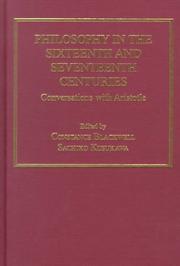
ISBN: 0860786684 Year: 1999 Publisher: Aldershot Ashgate
Abstract | Keywords | Export | Availability | Bookmark
 Loading...
Loading...Choose an application
- Reference Manager
- EndNote
- RefWorks (Direct export to RefWorks)
Philosophy, Renaissance --- Philosophy, Modern --- Renaissance philosophy --- Aristoteles --- Influence. --- Aristote --- Aristotle --- Aristotile --- Influence --- Arisṭāṭṭil --- Aristo, --- Aristotel --- Aristotele --- Aristóteles, --- Aristòtil --- Arisṭū --- Arisṭūṭālīs --- Arisutoteresu --- Arystoteles --- Ya-li-shih-to-te --- Ya-li-ssu-to-te --- Yalishiduode --- Yalisiduode --- Ἀριστοτέλης --- Αριστοτέλης --- Аристотел --- ארסטו --- אריםטו --- אריסטו --- אריסטוטלס --- אריסטוטלוס --- אריסטוטליס --- أرسطاطاليس --- أرسططاليس --- أرسطو --- أرسطوطالس --- أرسطوطاليس --- ابن رشد --- اريسطو --- Pseudo Aristotele --- Pseudo-Aristotle --- アリストテレス
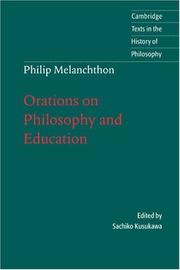
ISBN: 9781139164139 9780521583503 9780521586771 0585376956 9780585376950 1139164139 0521583500 0521586771 0511002009 9780511002007 Year: 1999 Publisher: Cambridge, U.K. New York Cambridge University Press
Abstract | Keywords | Export | Availability | Bookmark
 Loading...
Loading...Choose an application
- Reference Manager
- EndNote
- RefWorks (Direct export to RefWorks)
Philip Melanchthon (1497-1560), humanist and colleague of Martin Luther, is best known for his educational reforms, for which he earned the title Praeceptor Germaniae (the Teacher of Germany). His most influential form of philosophical writing was the academic oration, and this volume, first published in 1999, presents a large and wide-ranging selection of his orations and textbook prefaces translated into English. They set out his views on the distinction between faith and reason, the role of philosophy in education, moral philosophy, natural philosophy, astronomy and astrology, and the importance of philosophy to a true Christian, as well as his views on Classical philosophical authorities such as Plato and Aristotle and on contemporaries such as Erasmus and Luther. Powerfully influential in their time, inspiring many Protestant students to study philosophy, mathematics and natural philosophy, they illuminate the relationship between Renaissance and Reformation thought.
Philosophy --- Education --- Philosophy & Religion --- Children --- Education, Primitive --- Education of children --- Human resource development --- Instruction --- Pedagogy --- Schooling --- Students --- Youth --- Civilization --- Learning and scholarship --- Mental discipline --- Schools --- Teaching --- Training --- Early works to 1800 --- Arts and Humanities
| Listing 1 - 10 of 15 | << page >> |
Sort by
|

 Search
Search Feedback
Feedback About UniCat
About UniCat  Help
Help News
News